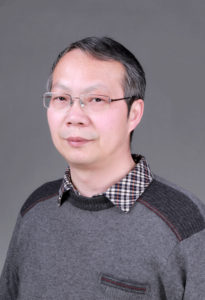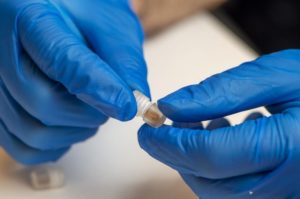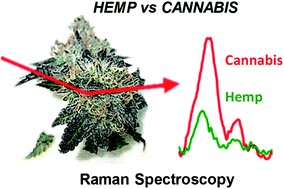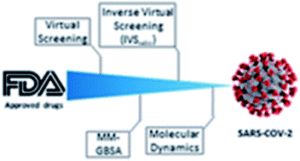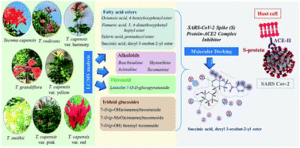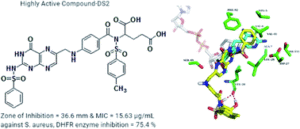Looking back at 2020, we would like to share with you some of the great research that has been published in RSC Advances over the year. We are proud to present a selection of the most popular 2020 chemical biology and medicinal chemistry papers, reviews and HOT articles published so far.
We hope you enjoy reading these articles and as always, all our articles are open access – free to read and accessible to everyone.
| 2020 HOT articles |
Over the year, our reviewers and Associate Editors have handpicked articles of particular interest and marked them as HOT. We are very pleased to highlight some outstanding 2020 chemical biology and medicinal chemistry HOT articles:
Accelerating the repurposing of FDA-approved drugs against coronavirus disease-19 (COVID-19)
Simona De Vita, Gianluigi Lauro, Giuseppe Bifulco et al., DOI: 10.1039/D0RA09010G
 In their article Giuseppe Bifulco, Gianluigi Lauro and colleagues at University of Salerno, Italy, developed a new computational protocol to identify FDA-approved drugs that could be used to fight the SARS-CoV-2 pandemic. Focussing on three SARS-CoV-2 targets; main protease, papain-like protease and spike protein, the researchers narrowed down the number of potential ligands by carrying out a virtual screening followed by applying the Inverse Virtual Screening approach previously developed by the research group. The best ligands for each protein were further investigated with molecular dynamics simulations confirming the promising binding modes.
In their article Giuseppe Bifulco, Gianluigi Lauro and colleagues at University of Salerno, Italy, developed a new computational protocol to identify FDA-approved drugs that could be used to fight the SARS-CoV-2 pandemic. Focussing on three SARS-CoV-2 targets; main protease, papain-like protease and spike protein, the researchers narrowed down the number of potential ligands by carrying out a virtual screening followed by applying the Inverse Virtual Screening approach previously developed by the research group. The best ligands for each protein were further investigated with molecular dynamics simulations confirming the promising binding modes.
‘Italy was one of the countries most affected by the first outbreak this spring and we felt the responsibility, as scientists, to contribute to the research of possible cures,’ says Bifulco. ‘We hope that our data can be used by other research groups as starting point to figure out new treatments for this disease. We are very confident about the results  achieved and we will keep on working on the matter.’
achieved and we will keep on working on the matter.’
Read the interview with the authors about their article here.
More HOT articles
Molecular targets and anticancer activity of quinoline–chalcone hybrids: literature review
Mamdouh F. A. Mohamed and Gamal El-Din A. Abuo-Rahma, DOI: 10.1039/D0RA05594H, Review
In silico identification of SARS-CoV-2 spike (S) protein–ACE2 complex inhibitors from eight Tecoma species and cultivars analyzed by LC-MS
Seham S. El Hawary, Usama Ramadan Abdelmohsen et al., DOI: 10.1039/D0RA08997D
P-stereocontrolled synthesis of oligo(nucleoside N3′→O5′ phosphoramidothioate)s – opportunities and limitations
Ewa Radzikowska, Barbara Nawrot et al., DOI: 10.1039/D0RA04987E
A novel cerium(III)–isatin Schiff base complex: spectrofluorometric and DFT studies and application as a kidney biomarker for ultrasensitive detection of human creatinine
Sheta M. Sheta, El-Sayed R. H. El-Gharkawy et al., DOI: 10.1039/C9RA10133K
A simple and cost-effective approach to fabricate tunable length polymeric microneedle patches for controllable transdermal drug delivery
Yongli Chen, Xu Zhang et al., DOI: 10.1039/D0RA01382J
Consensus virtual screening of dark chemical matter and food chemicals uncover potential inhibitors of SARS-CoV-2 main protease
Marisa G. Santibáñez-Morán, José L. Medina-Franco et al., DOI: 10.1039/D0RA04922K
Read the full HOT article collection
| Most popular 2020 articles |
Reviews
Nature as a treasure trove of potential anti-SARS-CoV drug leads: a structural/mechanistic rationale
Ahmed M. Sayed, Usama Ramadan Abdelmohsen et al., DOI: 10.1039/D0RA04199H
Synthesis and application of coumarin fluorescence probes
Xiao-ya Sun, Xiao-jing Wang et al., DOI: 10.1039/C9RA10290F
Benefits and applications of microwave-assisted synthesis of nitrogen containing heterocycles in medicinal chemistry
Maged Henary, Giancarlo Cravotto et al., DOI: 10.1039/D0RA01378A
Non-ionic small amphiphile based nanostructures for biomedical applications
Badri Parshad, Ljiljana Fruk et al. DOI: 10.1039/D0RA08092F
Papers
Facile approach to benzo[d]imidazole-pyrrolo[1,2-a]pyrazine hybrid structures through double cyclodehydration and aromatization and their unique optical properties with blue emission
Gi Hun Bae, Ikyon Kim et al., DOI: 10.1039/D0RA01140A
Synthesis of phosphonoacetate analogues of the second messenger adenosine 5′-diphosphate ribose (ADPR)
Ondřej Baszczyňski, Barry V. L. Potter et al., DOI: 10.1039/C9RA09284F
Evaluation of cytotoxic potential of structurally well-characterized RNA targeted ionic non-steroidal anti-inflammatory (NSAID) Cu(II) & Zn(II) DACH–mefenamato drug conjugates against human cancer cell lines
Huzaifa Yasir Khan, Farukh Arjmand et al., DOI: 10.1039/C9RA07464C
Two novel ACE inhibitory peptides isolated from longan seeds: purification, inhibitory kinetics and mechanisms
Atthasith Nuchprapha, Aphichart Karnchanatat et al., DOI: 10.1039/D0RA00093K
Antibiofilm, antimicrobial and cytotoxic activity of extracellular green-synthesized silver nanoparticles by two marine-derived actinomycete
Ahmed A. Hamed, Ahmed N. Emam et al., DOI: 10.1039/D0RA11021F
Enhancement of ibuprofen solubility and skin permeation by conjugation with L-valine alkyl esters
Ewa Janus, Adam Klimowicz et al. DOI: 10.1039/D0RA00100G
Extracellular electron transfer mediated by a cytocompatible redox polymer to study the crosstalk among the mammalian circadian clock, cellular metabolism, and cellular redox state
Masahito Ishikawa, Katsutoshi Hori et al., DOI: 10.1039/C9RA10023G
Development and characterization of a babassu nut oil-based moisturizing cosmetic emulsion with a high sun protection factor
Michael Jackson Ferreira da Silva, Maria Célia Costa Pires et al., DOI: 10.1039/D0RA00647E
Histidine-conjugated DNA as a biomolecular depot for metal ions
Soyoung Park, Hiroshi Sugiyama et al., DOI: 10.1039/D0RA01267J
High-throughput toxicity screening of novel azepanium and 3-methylpiperidinium ionic liquids
Angela L. Tether, Stephen A. Kelly et al., DOI: 10.1039/D0RA03107K
A ZnII complex of ornidazole with decreased nitro radical anions that is still highly active on Entamoeba histolytica
Promita Nandy, Saurabh Das et al., DOI: 10.1039/D0RA02597F
Synthesis of tricyclic carbohydrate–benzene hybrids as selective inhibitors of galectin-1 and galectin-8 N-terminal domains
Chunxia Wu, Yuanyuan Zhang et al., DOI: 10.1039/D0RA03144E
 Submit to RSC Advances today! Check out our author guidelines for information on our article types or find out more about the advantages of publishing in a Royal Society of Chemistry journal.
Submit to RSC Advances today! Check out our author guidelines for information on our article types or find out more about the advantages of publishing in a Royal Society of Chemistry journal.
Keep up to date with our latest HOT articles, Reviews, Collections & more by following us on Twitter. You can also keep informed by signing up to our E-Alerts.











